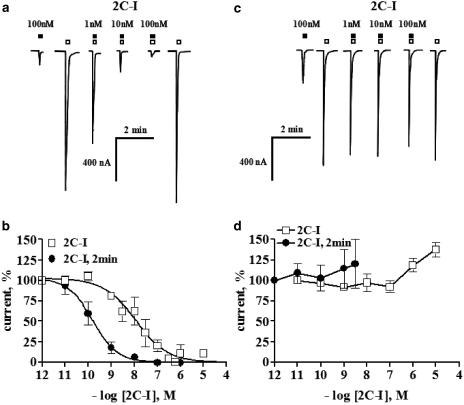Figure 2.
Selective 5-HT2A receptor antagonism by 2-CI (2,5-dimethoxy-4-iodo-phenyl)ethylamine. (a) Representative tracing illustrates the blockade of the 100 nM 5-HT-evoked current by coapplication of 1, 10 or 100 nM 2C-I to a single oocyte expressing 5-HT2A receptors. Solid squares represent 2C-I applications, open squares depict 100 nM 5-HT additions. Note that 100 nM 2C-I alone caused a small reproducible current, consistent with its partial agonism. (b) The coapplication of different concentrations of 2C-I plus 100 nM 5-HT blocked the 5-HT-induced currents in a concentration-dependent manner at the 5-HT2A receptor (open squares). A 2-min preapplication of 2C-I increased the magnitude of the blockade about 100-fold (solid circles). (c) Representative polygraph recording shows, in the same oocyte, that 2C-I did not significantly reduce the 10 nM 5-HT-evoked currents at the 5-HT2C receptor. Solid squares represent the 2C-I applications; open squares depict 10 nM 5-HT additions. Consonant with its partial agonist profile, 100 nM 2C-I per se caused a current amounting to 35% of the 10 nM 5-HT response. (d) 2C-I did not block the 10 nM 5-HT-induced currents in an oocyte expressing 5-HT2C receptors when 2C-I was either coapplied or preapplied for 2 min. Coapplications of 2C-I larger than 3 nM were not tested in view of its partial agonism. Symbols indicate the mean average normalized current, and, bars the s.e.m. At least four separate oocytes from two batches of oocytes were analyzed per protocol in all panels.

